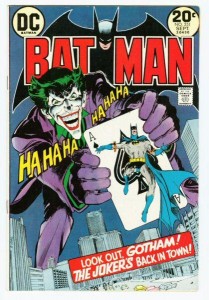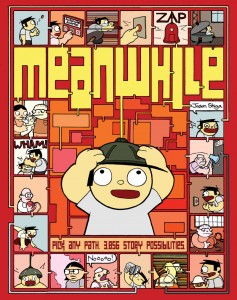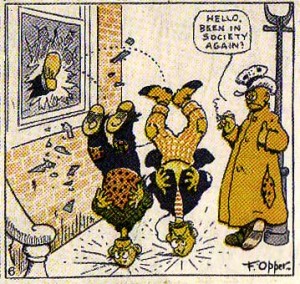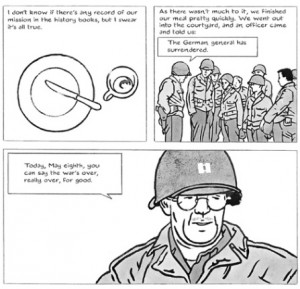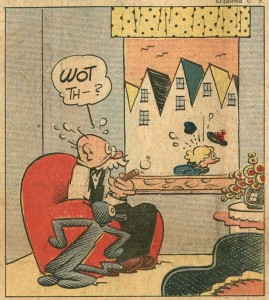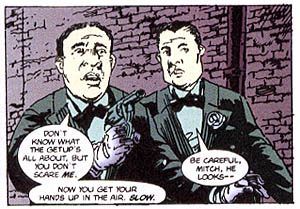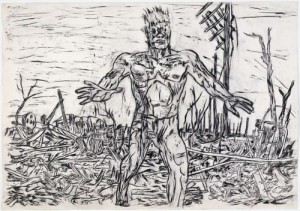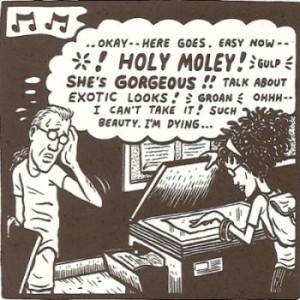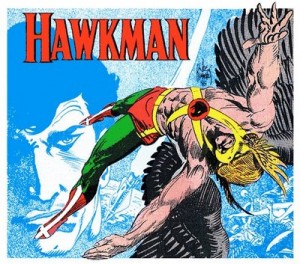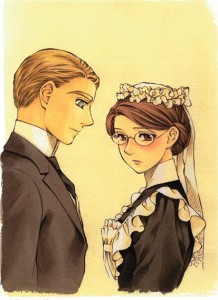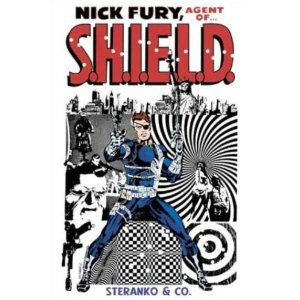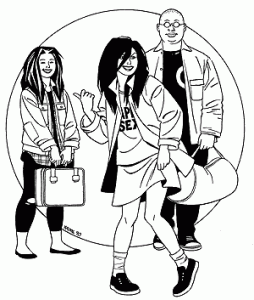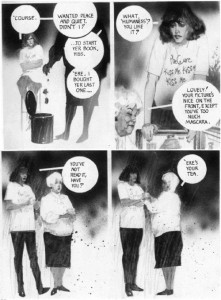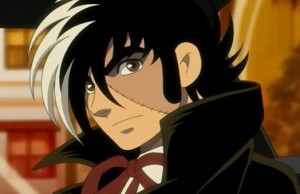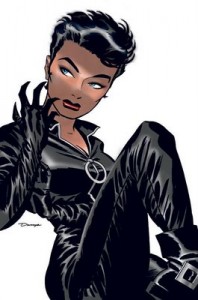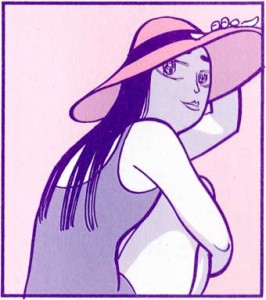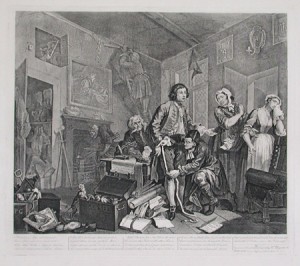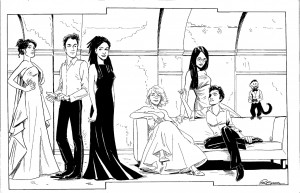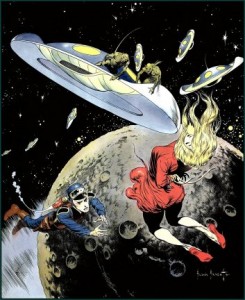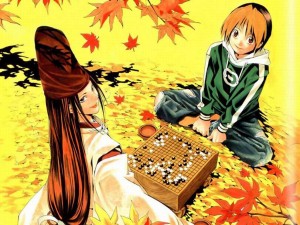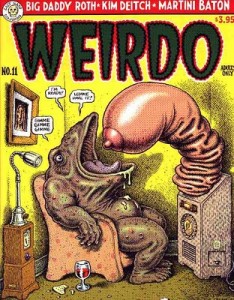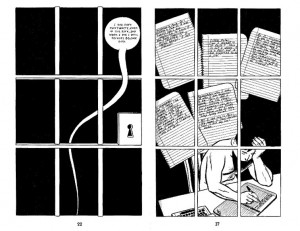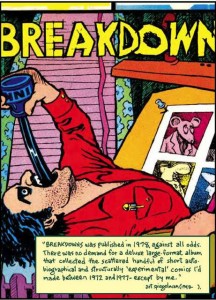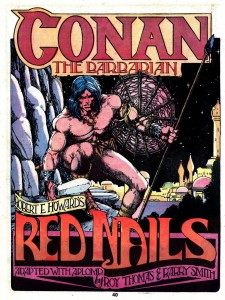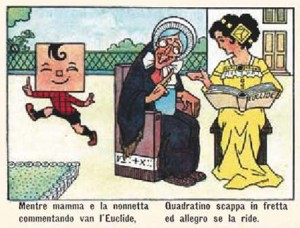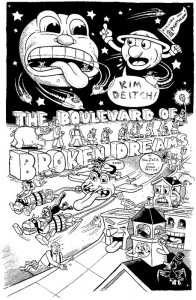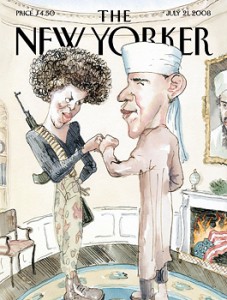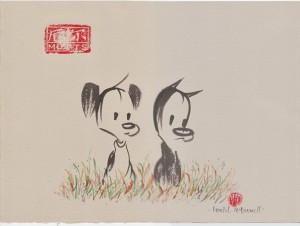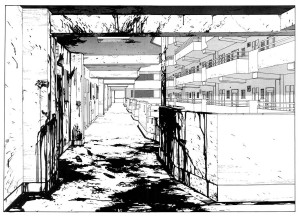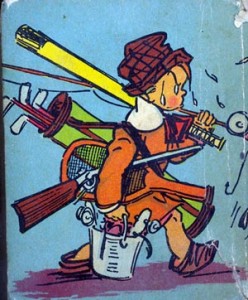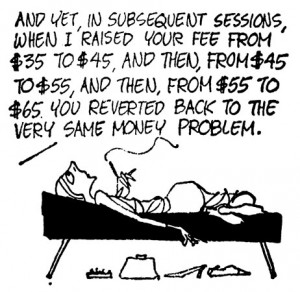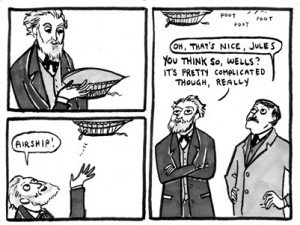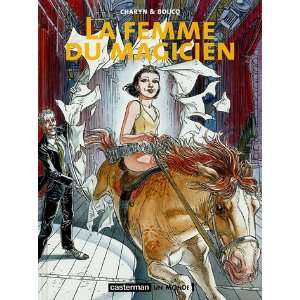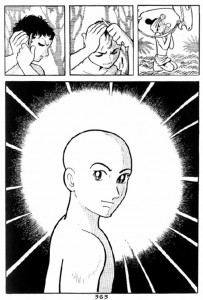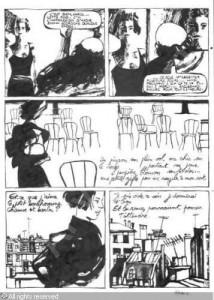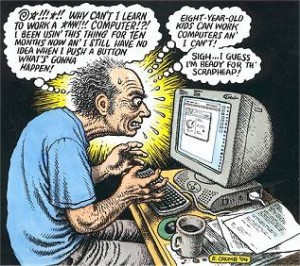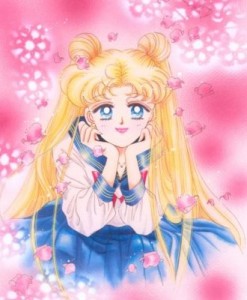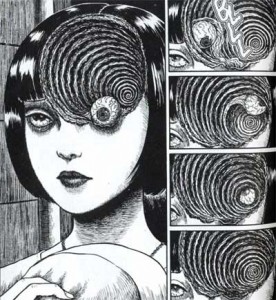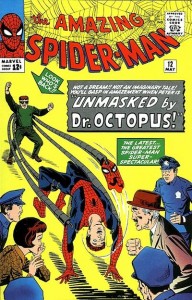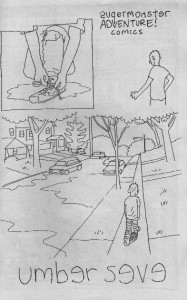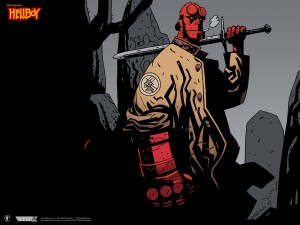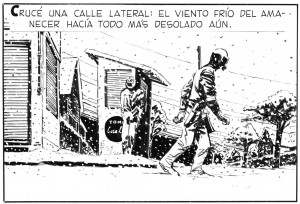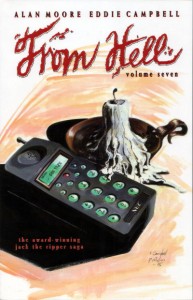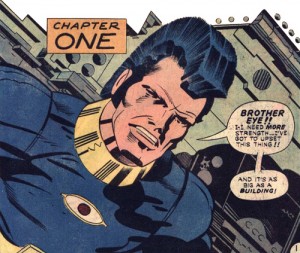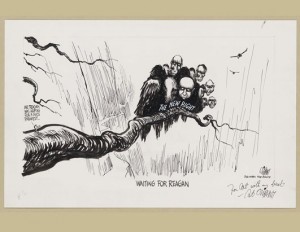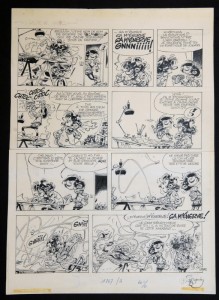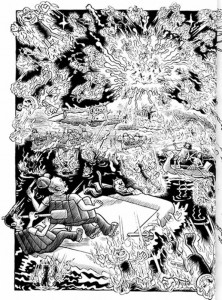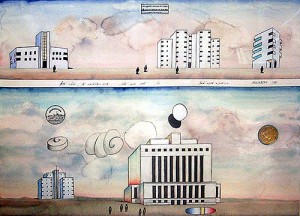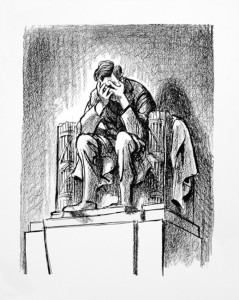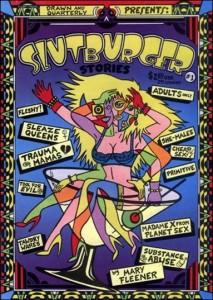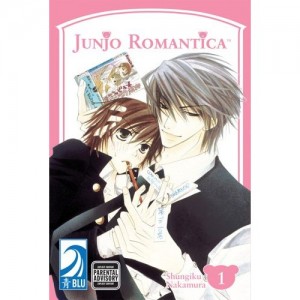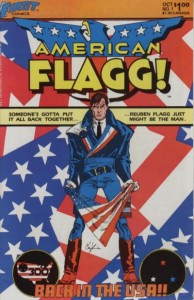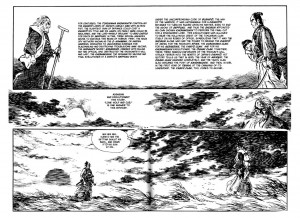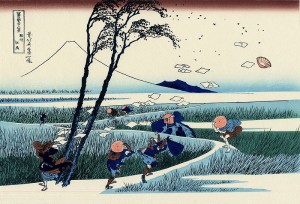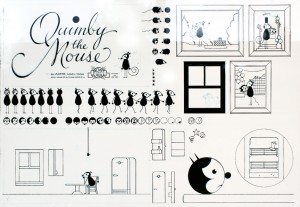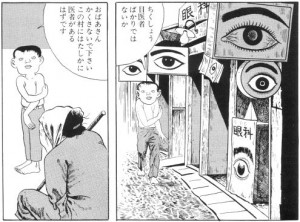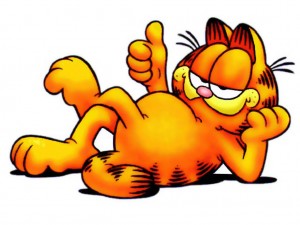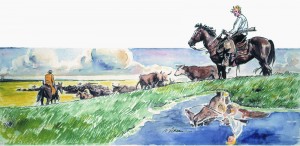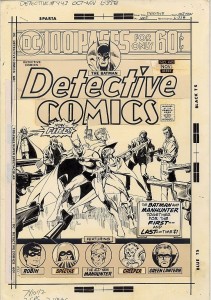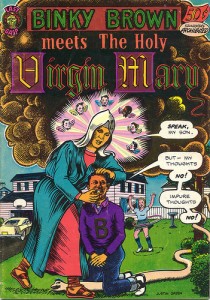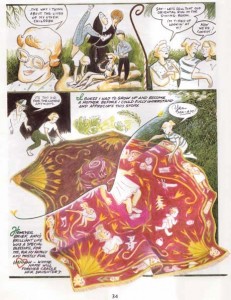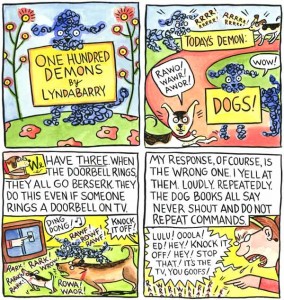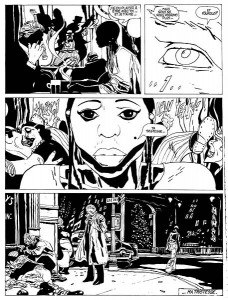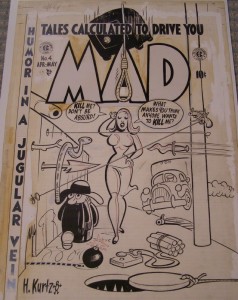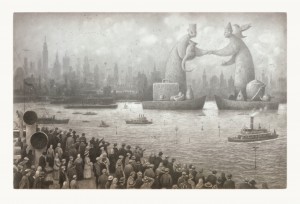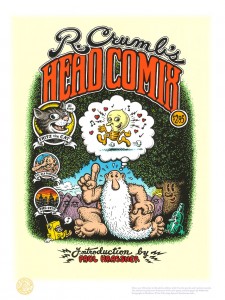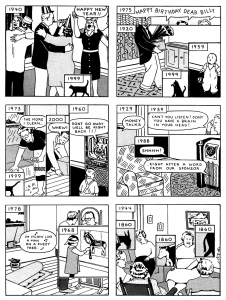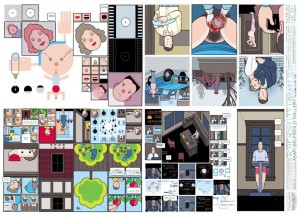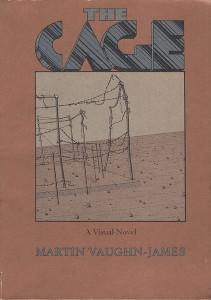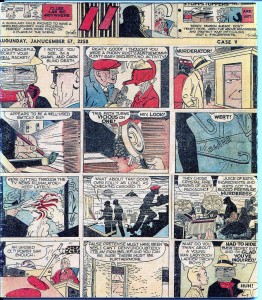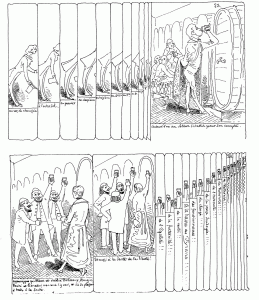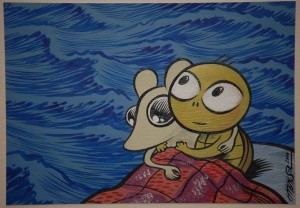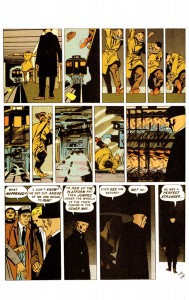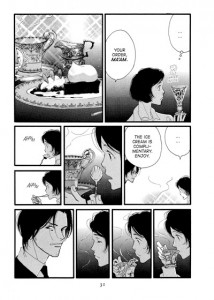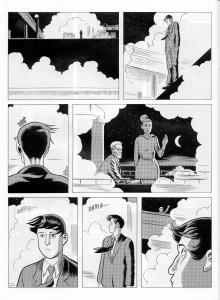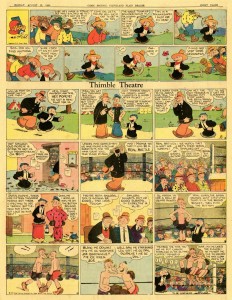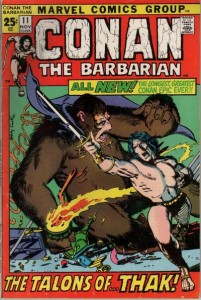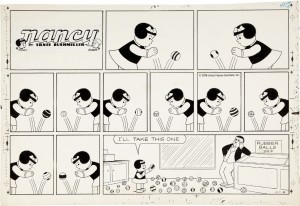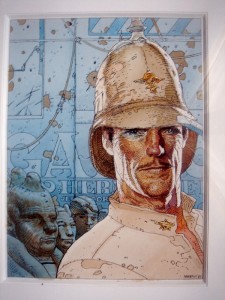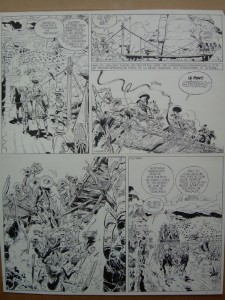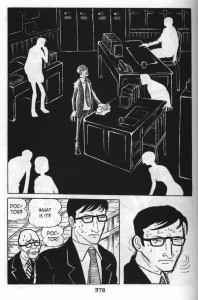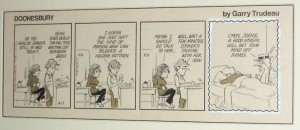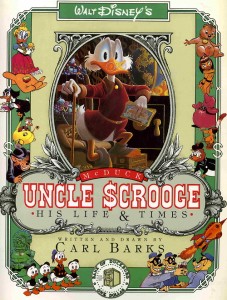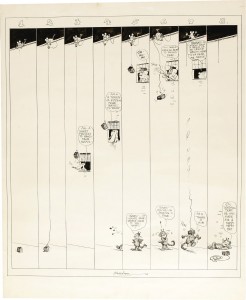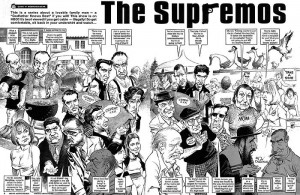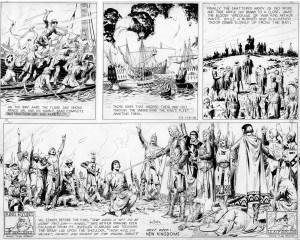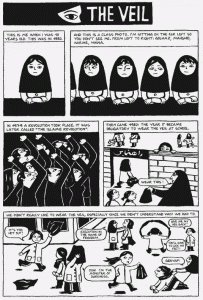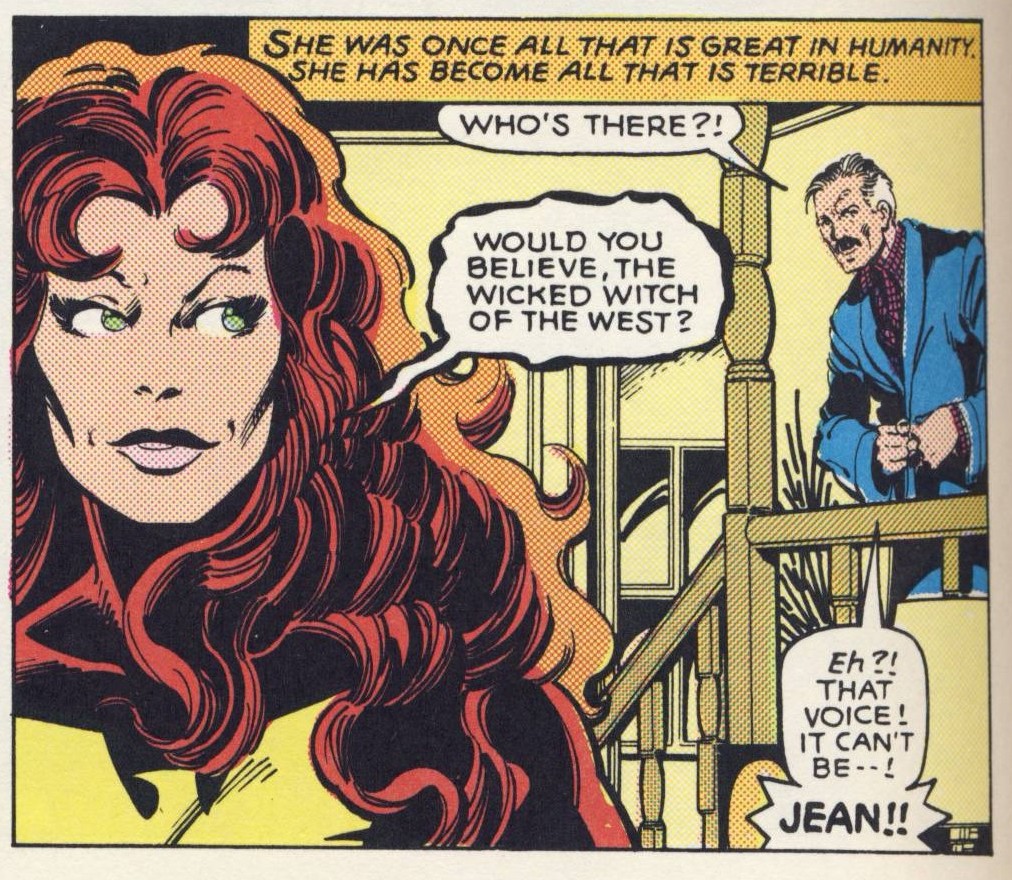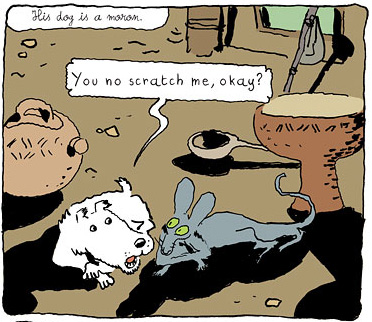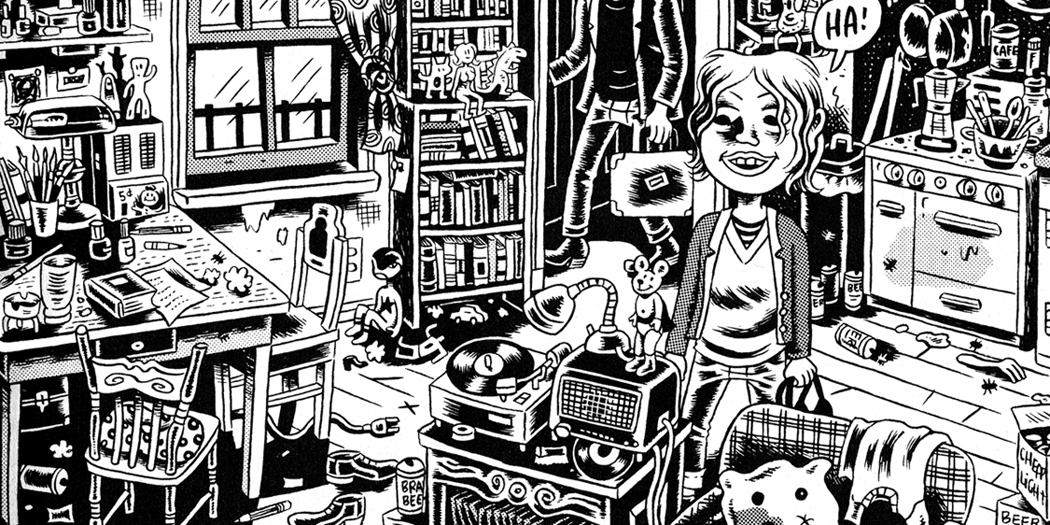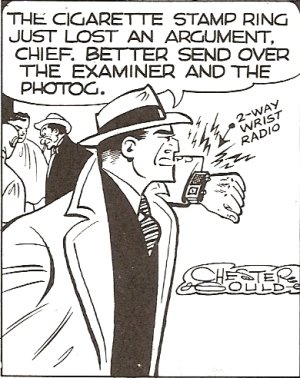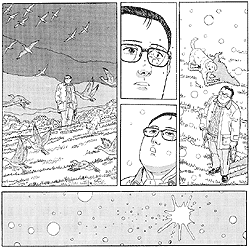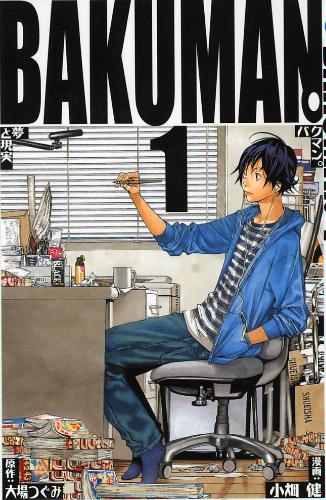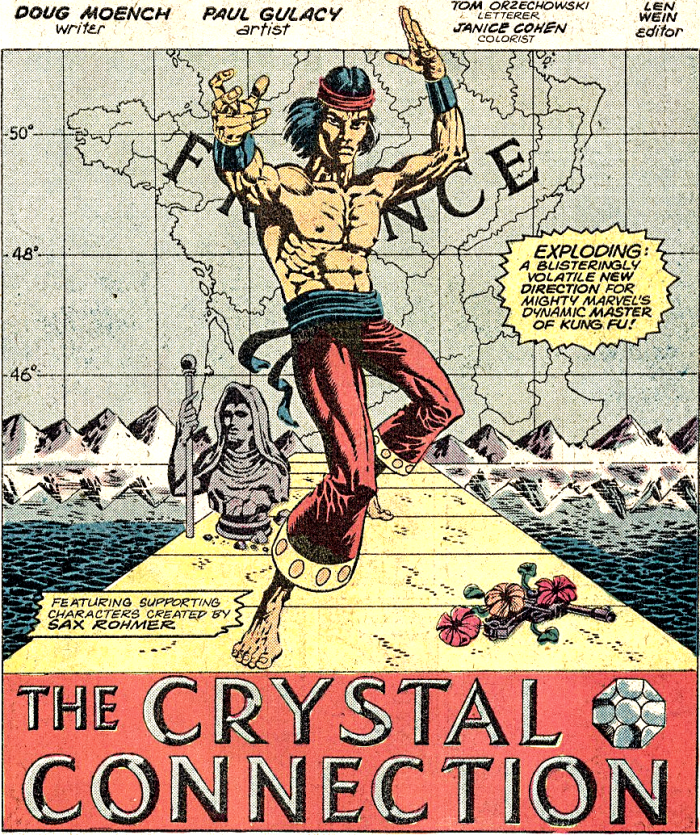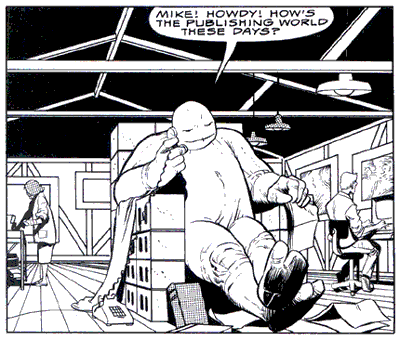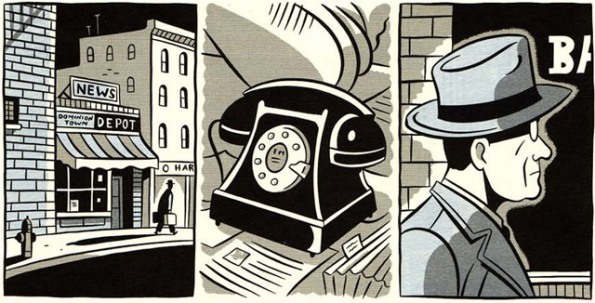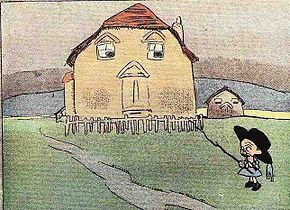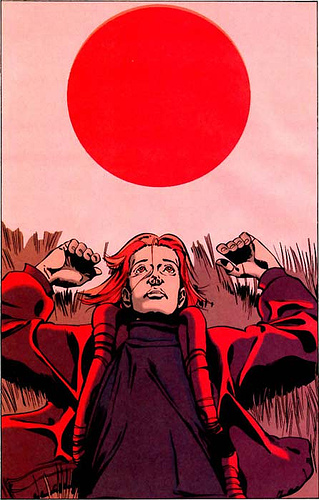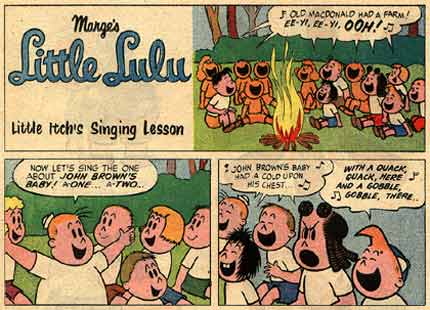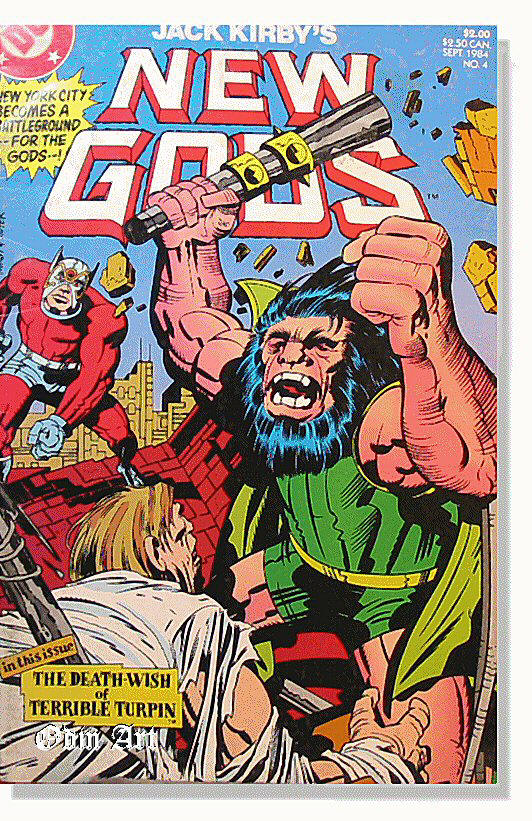The following lists were submitted in response to the question, “What are the ten comics works you consider your favorites, the best, or the most significant?” All lists have been edited for consistency, clarity, and to fix minor copy errors. Unranked lists are alphabetized by title. In instances where the vote varies somewhat with the Top 115 entry the vote was counted towards, an explanation of how the vote was counted appears below it.
In the case of divided votes, only works fitting the description that received multiple votes on their own received the benefit. For example, in Jessica Abel’s list, she voted for The Post-Superhero comics of David Mazzucchelli. That vote was divided evenly between Asterios Polyp and Paul Auster’s City of Glass because they fit that description and received multiple votes on their own. It was not in any way applied to the The Rubber Blanket Stories because that material did not receive multiple votes from other participants.
Matthew Tauber
Writer, www.matttauber.blogspot.com
The New Teen Titans, Marv Wolfman & George Pérez
- Barnaby, Crockett Johnson
- The Conan the Barbarian Stories, Kurt Busiek & Cary Nord
- The Daredevil Stories, Brian Michael Bendis & Alex Maleev
- The Fantastic Four Stories, John Byrne
- The MAD “Marginal” Cartoons, Sergio Aragonés
- The New Teen Titans Stories, Marv Wolfman & George Pérez
- Peanuts, Charles M. Schulz
- The Tarzan Stories, Joe Kubert
- Terry and the Pirates, Milton Caniff
- The Two-Fisted Tales Stories, John Severin
Counted as a vote for The EC Comics War Stories, Harvey Kurtzman & John Severin, Wallace Wood, Jack Davis, et al.
______________________________________________
Ty Templeton
Cartoonist, Stig’s Inferno; illustrator, Batman Adventures
Batman, Denny O’Neil & Neal Adams
- The Arzach Stories, Jean “Moebius” Giraud
- A Contract with God and Other Tenement Stories, Will Eisner
- “Corpse on the Imjin,”, Harvey Kurtzman
Counted as a vote for The EC Comics War Stories, Harvey Kurtzman & John Severin, Wallace Wood, Jack Davis, et al. - “The Dark Knight Returns,” Frank Miller, with Klaus Janson & Lynn Varley
Counted as a vote for Batman: The Dark Knight Returns - “The Joker’s Five-Way Revenge,” Denny O’Neil & Neal Adams
- Maus: A Survivor’s Tale Art Spiegelman
- “The Pact!”, Jack Kirby, with Mike Royer
Counted as a vote for The Fourth World Stories, Jack Kirby, with Mike Royer, et al. - Pogo, Walt Kelly
- “Superduperman,” Harvey Kurtzman & Wallace Wood
Counted as a vote for MAD #1-28, Harvey Kurtzman & Will Elder, Wallace Wood, Jack Davis, et al. - Watchmen, Alan Moore & Dave Gibbons
COMMENTS
I decided that the best way to sum up a top ten (in no order of preference, since that would drive me to madness) was to list the creator (or team in the case of O’Neil and Adams) as a body of work, and then pick my favorite single issue to serve as an example of that artist. I hope that helps.
– Harvey Kurtzman’s complete work, focusing on MAD and the EC war books, and if I must bring it down to one story, it’s “Corpse on the Imjin,” from Frontline Combat.
– Jack Kirby’s complete body of work – but to reduce it to one single comic book series, it’s New Gods and down to one single issue it’s New Gods #7, “The Pact!”.
– Moebius – Arzach, the collected stories.
– Denny O’Neil/Neal Adams, their complete collaborative works (including Green Lantern/Green Arrow, Batman, and Superman vs. Muhammad Ali). If I must reduce it to one issue, it’s Batman #251 “The Joker’s Five Way Revenge.”
-Wally Wood’s body of work, focusing on EC and MAD magazine, and if I must narrow it down to a single story, I’ll pick “Superduperman” from the MAD comic book by Kurtzman and Wood.
– Alan Moore’s complete body of work, but pushing into just one choice, it’s Watchmen by Moore and Dave Gibbons.
– Maus by Spiegelman.
– Will Eisner’s complete body of work, but reduced to one choice it’s his graphic novel, A Contract with God.
– Frank Miller’s work on Daredevil, Ronin, some of Sin City, and most of his work on Batman (except Spawn/Batman and DK2, which were dreadful). If I must give it just one issue as an example it’s Batman: The Dark Knight Returns #1.
– Walt Kelly’s Pogo. From the first Albert and Pogo comics, to the syndicated strip, Pogo was perfect from inception to end. To pick just one specific page is impossible.
______________________________________________
Jason Thompson
Author, Manga: The Complete Guide; co-creator & scriptwriter, King of RPGs;
Meanwhile, Jason Shiga
- Achewood, Chris Onstad
- Beirusayu no Bara [The Rose of Versailles], Riyoko Ikeda
- Cerebus, Dave Sim & Gerhard
- The Doom Patrol Stories, Grant Morrison & Richard Case, with Scott Hanna, et al.
- Jojo no Kimyô na Bôken [Jojo’s Bizarre Adventure], Hirohiko Araki
- Meanwhile, Jason Shiga
- The New Yorker Cartoons, Roz Chast
- Peanuts, Charles M. Schulz
- Pogo, Walt Kelly
- Tintin, Hergé
COMMENTS
Here are my choices of ten great comics. They’re all series that are either extremely well-crafted, very touching to me for personal reasons, or very powerful and cohesive in expressing the artist’s persona, which is the best thing that can be said about any work of art (at least, right alongside and perpetually struggling with the other great goal of “being entertaining to the reader”).
______________________________________________
Kelly Thompson
Writer, 1979 Semi-Finalist; contributing writer, Comic Book Resources
Lint, Chris Ware
- 1. The ACME Novelty Library #20 (“Lint”), Chris Ware
- 2. Batwoman: Elegy, Greg Rucka & J. H. Williams III
- 3. Black Hole, Charles Burns
- 4. Calvin and Hobbes, Bill Watterson
- 5. Planetary, Warren Ellis & John Cassaday
- 6. Love and Rockets, Gilbert Hernandez & Jaime Hernandez
Counted as a 0.5 vote each for The Locas Stories, Jaime Hernandez, and The Palomar Stories, Gilbert Hernandez - 7. Y: The Last Man, Brian K. Vaughan & Pia Guerra, with José Márzan, Jr., et al.
- 8. Nextwave: Agents of H.A.T.E., Warren Ellis & Stuart Immonen
- 9. Maus: A Survivor’s Tale, Art Spiegelman
- 10. Unlikely, Jeffrey Brown
______________________________________________
Matt Thorn
Associate Professor, Faculty of Manga, Kyoto Seika University
Happy Hooligan, Frederick Opper
- The Arzach Stories, Jean “Moebius” Giraud
- Happy Hooligan, Frederick Opper
- Histoire de M. Jabot [The Story of Mr. Jabot], Rodolphe Töpffer
Counted as a vote for Works, Rodolophe Töpffer - Kinkin Sensei Eiga no Yume [Master Flashgold’s Splendiferous Dream], Harumachi Koikawa
- Little Nemo in Slumberland, Winsor McCay
- The Little Lulu Stories, John Stanley, with Irving Tripp & Charles Hedinger
- Metropolis, Osamu Tezuka
- “Tanjô!”, Yumiko Ôshima
- Terry and the Pirates, Milton Caniff
- Watchmen, Alan Moore & Dave Gibbons
COMMENTS
These are not my personal favorites, but rather ten comics I think are historically important, either because of their influence on later work, or because they were groundbreaking.
1) Master Flashgold’s Splendiferous Dream (Kinkin Sensei Eiga no Yume), by Harumachi Koikawa, 1775, Japan. Possibly the world’s first true graphic novel to reach a wide audience and turn a profit for its creator and publisher. Unlike most early European sequential art, the text is in incorporated within the image. Printed using the sophisticated woodblock technology of the day, this bestseller kicked off the entire genre of single-volume “kibyôshi” (“yellow covers”) and multi-volume “gôkan” (“combined volumes”) that remained hugely popular among merchant-class Japanese until moveable type pretty much killed the woodblock print.
2) The Story of Mr. Jabot (Histoire de M. Jabot), by Rodolphe Töpffer, 1833, Switzerland. Is there any doubt that popular Western sequential art pretty much begins with Töpffer? Sure, there are earlier examples of sequential art, but nothing came close to the popular success and impact of Töpffer’s works, which are still hilarious and inspiring today.
3) Happy Hooligan, by Fred Opper, 1900-1932, U.S.A.. I think it’s fair to say that Opper was the first to bring all the major elements of modern comics together, consistently, and make them the lingua franca of the newspaper funnies and early comic books. Speech balloons? Check. No distracting narration outside the panels? Check. Lines and other devices to illustrate motion, impact, and other “invisible” elements? Check. Whether or not you think the work has aged well is a matter of taste, I suppose.
4) Little Nemo in Slumberland” by Winsor McCay, 1905-1914, U.S.A.. McCay couldn’t write a coherent line of dialogue to save his life, but, oh, Prunella, could that guy draw some wicked stuff. He expanded the visual grammar of comics exponentially. A century later, it still makes for brilliant eye candy.
5) Terry and the Pirates, by Milton Caniff, 1934-1946, U.S.A.. The funnies grow up. And an artist stands up for creator rights.
6) Little Lulu, written by John Stanley, drawn by Stanley, Irving Tripp and Charles Hedinger, 1945-1959, U.S.A.. Stanley’s Little Lulu is probably the smartest, funniest, most carefully crafted children’s comic book ever created, with the possible exception of Carl Barks’ duck books. And Lulu was probably the ideal role model for postwar American girls. Compared to Lulu, almost every other comic created for children in the history of the medium seems like greasy kids’ stuff. At least until Jill Thompson gave us the “Scary Godmother.
7) Metropolis, by Osamu Tezuka, 1949, Japan. This, along with Tezuka’s “Lost World (1948) and The World to Come (Kitaru Beki Sekai
8) “Birth!” (“Tanjô!”), by Yumiko Ôshima, 1970, Japan. This profound and moving short story about a pregnant high-school girl struggling to decide whether or not to have an abortion took “girls” comics” to a whole new plane, and had an enormous influence on other young Japanese women cartoonists. Within a few short years, Japanese girls’ comics were transformed from an object of scorn to the cutting edge of the manga world.
9) Arzach, by Jean “Moebius” Giraud, 1975, France. Gorgeous detail! Psychedelic pterosaurs! Flopping penises! The sophistication and (dare I say) miss en scène of Moebius’ sci-fi vision continues to exert mind-boggling influence on creators working in a wide range of media, all over the world.
10) Watchmen, by Alan Moore and Dave Gibbons, 1986-1987, U.S.A.. This is probably on most people’s lists, but I think it’s hard to overstate how brilliant this book is on so many levels. Too bad Warner Bros. chose the single most inappropriate director for the film. Who would look at Gibbons’ stoic, tic-tac-toe layouts and stifled characters and think, “Hey, let’s get the guy who directed 300 to do this!”? I would have gone with Wim Wenders.
______________________________________________
Tom Tirabosco
Cartoonist, L’Émissiare [The Emissary], L’Oeil de la forêt [The Eye of the Forest]
La Guerre d’Alan, Emmanuel Guibert
- L’Ascension du haut-mal [Epileptic], David B.
- Asterios Polyp, David Mazzucchelli
- Black Hole, Charles Burns
- Blast, Manu Larcenet
- La Guerre d’Alan [Alan’s War], Emmanuel Guibert
- Haruka na Machi-e [A Distant Neighborhood], Jiro Taniguchi
- Jimmy Corrigan: The Smartest Kid on Earth, Chris Ware
- Monsieur Jean [Get a Life], Philippe Dupuy & Charles Berberian
- Pascin, Joann Sfar
- Tintin au Tibet [Tintin in Tibet], Hergé
______________________________________________
Mark Tonra
Cartoonist, James, Top of the World
Polly and Her Pals, Cliff Sterrett
- Krazy Kat, George Herriman
- Peanuts, Charles M. Schulz
- Pogo, Walt Kelly
- Polly and Her Pals, Cliff Sterrett
- Thimble Theatre, starring Popeye, E. C. Segar
- Works, George Booth
- Works, Jules Feiffer
Counted as a vote for Feiffer and Sick, Sick, Sick - Works, B. Kliban
- Works, Sempé
- Works, Saul Steinberg
______________________________________________
Noel Tuazon
Cartoonist, Obese Obsessor; co-creator & illustrator, This Is Where I Am
Sandman Mystery Theatre, Matt Wagner, Steven T. Seagle, and Guy Davis
- Barney et la note bleue [Barney and the Blue Note], Jacques Loustal & Philippe Paringaux
- Bouche du diable [Billy Budd, KGB], Jerome Charyn & François Boucq
- La Femme du magicien [The Magician’s Wife], Jerome Charyn & François Boucq
- Fuochi [Fires], Lorenzo Mattotti
- “The Hourman”, Matt Wagner, Steven T. Seagle, and Guy Davis
- Idyl, Jeffrey Catherine Jones
- Lloyd Llewellyn, Daniel Clowes
- The Sandman Mystery Theatre Stories, Steven T. Seagle & Guy Davis, et al.
- The Shadow Stories, Denny O’Neil & Michael W. Kaluta
- Swamp Thing, Len Wein & Bernie Wrightson
- Binky Brown Meets the Holy Virgin Mary, Justin Green
- Nancy, Ernie Bushmiller
- Nancy and Sluggo Go to Summer Camp, John Stanley
- Works, R. Crumb (most things)
Counted as a 0.333 vote each for The Book of Genesis Illustrated, The Counterculture-Era Stories, and The Weirdo-Era Stories - The Brinkley Girls, Nell Brinkley
- Colin-Maillard [Heartthrobs], Max Cabanes
- Corto Maltese: La ballade de la mer salée [The Ballad of the Salt Sea], Hugo Pratt
- La Femme du magicien [The Magician’s Wife], Jerome Charyn & François Boucq
- “Hell and Back,” Frank Miller & Bill Sienkiewicz [Elektra: Assassin #1]
Counted as a vote for Elektra: Assassin, Frank Miller & Bill Sienkiewicz - L’Homme est il bon? [Man Is Good?], Jean “Moebius” Giraud
- The ‘Nam, Doug Murray & Michael Golden, with John Beatty, et al.
- 100%, Paul Pope
- Rônin, Frank Miller, with Lynn Varley
- “A Small Place in Hell,” Jack Kirby, with D. Bruce Berry [Our Fighting Forces #152]
- Arman & Ilva, Lo Hartog van Banda & Thé Tjong Khing
- Astérix le gaulois [Astérix the Gaul], René Goscinny & Albert Uderzo
- The Gospel Stories, Chester Brown
- Jimbo, Gary Panter
- “Life o’ Bub,”, David Hornung
- The Lucky Luke Stories, Morris & René Goscinny
- The Rubber Blanket Stories, David Mazzucchelli
- Suske en Wiske [Willy and Wanda], Willy Vandersteen
- Thimble Theatre, starring Popeye, E. C. Segar
- Travel, Yuichi Yokoyama
- 1. Jimmy Corrigan: The Smartest Kid on Earth, Chris Ware
- 2. Ice Haven, Daniel Clowes
- 3. Misery Loves Comedy, Ivan Brunetti
- 4. The Girl from H.O.P.P.E.R.S., Jaime Hernandez
Counted as a vote for The Locas Stories - 5. Louis Riel, Chester Brown
- 6. The Complete Crumb Comics, Volume 17, R. Crumb
Counted as a vote for The Weirdo-Era Stories - 7. Funny Misshapen Body, Jeffrey Brown
- 8. Map of My Heart, John Porcellino
Counted as a vote for King-Cat Comics and Stories - 9. The Poor Bastard, Joe Matt
- 10. My New York Diary, Julie Doucet
- Asterios Polyp, David Mazzucchelli
- Aya, Marguerite Abouet & Clement Oubrerie
- Le Chat du rabbin [The Rabbi’s Cat], Joann Sfar
- Fuzz and Pluck, Ted Stearn
- Goodbye, Chunky Rice, Craig Thompson
- Laika, Nick Abadzis
- Persepolis, Marjane Satrapi
- Skim, Mariko Tamaki & Jillian Tamaki
- Spaniel Rage, Vanessa Davis
- The Unsinkable Walker Bean, Aaron Renier
- American Flagg!, Howard Chaykin
- The Hawkman Stories, Gardner Fox & Joe Kubert
- MAD #1-28, Harvey Kurtzman & Will Elder, Wallace Wood, Jack Davis, et al.
- The Spirit, Will Eisner
- Stuntman, Joe Simon & Jack Kirby
- The Uncle $crooge Stories, Carl Barks
- Weird Science-Fantasy, Al Feldstein, editor
Counted as a vote for The EC Comics Science-Fiction Stories, Al Feldstein & Wallace Wood, Al Williamson, Joe Orlando, et al. - Aruku Hito [The Walking Man], Jiro Taniguchi
- Castle Waiting, Linda Medley
- The Defenders Stories, Steve Gerber & Sal Buscema
- Doonesbury, Garry B. Trudeau
- Emma, Kaoru Mori
- Furûtsu Basaketto [Fruits Basket], Natsuki Takaya
- Kurosagi Shitai Takuhaibin [The Kurosagi Corpse Delivery Service], Eiji Ôtsuka & Housai Yamazaki
- MW, Osamu Tezuka
- One Piece, Eiichiro Oda
- Seiyô Kottô Yôgashiten [Antique Bakery], Fumi Yoshinaga
- 1. Little Nemo in Slumberland, Winsor McCay
- 2. The Long Tomorrow, Dan O’Bannon & Jean “Moebius” Giraud
- 3. Los Tejanos, Jack Jackson
- 4. The Weirdo Stories, R. Crumb
- 5. Krazy Kat, George Herriman
- 6. Spider-Man, Stan Lee & Steve Ditko
- 7. The Superman Stories, Mort Weisinger & Curt Swan, Wayne Boring, et al.
- 8. “Here,” Richard McGuire
- 9. Starstruck, Elaine Lee & Michael Kaluta
- 10. Two-Fisted Tales, Harvey Kurtzman, editor
- American Born Chinese, Gene Luen Yang
- Bayou, Jeremy Love
- Fun Home, Alison Bechdel
- Jimmy Corrigan: The Smartest Kid on Earth, Chris Ware
- “Judgment Day,” Al Feldstein & Joe Orlando
Counted as a vote for The EC Comics Science-Fiction Stories, Al Feldstein & Wallace Wood, Al Williamson, Joe Orlando, et al. - Maus: A Survivor’s Tale, Art Spiegelman
- Nat Turner, Kyle Baker
- Stagger Lee, Derek McCulloch & Shepherd Hendrix
- Watchmen, Alan Moore & Dave Gibbons
- X-Men: God Loves, Man Kills, Chris Claremont & Brent Anderson
- The Biologic Show, Al Columbia
- Dr. Slump, Akira Toriyama
- Eightball, Daniel Clowes
Counted as a 0.2 vote each for Caricature: Nine Stories, David Boring, The Death Ray, Ghost World, and Ice Haven - Krazy Kat, George Herriman
- The MAD Stories, Will Elder
Counted as a vote for MAD #1-28, Harvey Kurtzman & Will Elder, Wallace Wood, Jack Davis, et al. - The New Yorker Cartoons, Charles Addams
- Prison Pit, Johnny Ryan
- Stardust the Super Wizard, Fletcher Hanks
- Thimble Theatre, starring Popeye, E. C. Segar
- Tintin, Hergé
- Akira, Katsuhiro Otomo
- Black Kiss, Howard Chaykin
- Calvin and Hobbes, Bill Watterson
- The Doom Patrol Stories, Grant Morrison & Richard Case, with Scott Hanna, et al.
- Elektra: Assassin, Frank Miller & Bill Sienkiewicz
- Le Garage hermétique [The Airtight Garage], Jean “Moebius” Giraud
- The Nick Fury, Agent of S.H.I.E.L.D. Stories, Jim Steranko, with Joe Sinnott, et al.
- The Nikopol Trilogy, Enki Bilal
- Scud: The Disposable Assassin, Rob Schrab
- The Winter Men, Brett Lewis & John Paul Leon
- The Disney Comics (c.1948-1954), Carl Barks
Counted as a vote forThe Donald Duck and Uncle $crooge Stories, Carl Barks - The Fourth World Stories, Jack Kirby, with Mike Royer, et al.
- Le Garage hermétique, Jean “Moebius” Giraud
- Hi no Tori [Phoenix], Osamu Tezuka
- Die Hure H [W the Whore], Katrin de Vries & Anke Feuchtenberger
- Krazy Kat, George Herriman
- The Locas Stories, Jaime Hernandez
- Mûno no Hito [The Talentless Man], Yoshiharu Tsuge
- Peanuts, Charles M. Schulz
- Tintin au Tibet [Tintin in Tibet], Hergé
- Big Numbers, Alan Moore & Bill Sienkiewicz
- Black Hole, Charles Burns
- Cerebus, Dave Sim & Gerhard
- Footnotes in Gaza, Joe Sacco
- The Frank Stories, Jim Woodring
- Fun Home, Alison Bechdel
- Judge Dredd, John Wagner, et al.
- Krazy Kat, George Herriman
- The Love and Rockets Stories, Jaime Hernandez
Counted as a vote for The Locas Stories - Mister O, Lewis Trondheim
- Battle Royale, Koushun Takami & Masayuki Taguchi
- Black Jack, Osamu Tezuka
- Dr. Slump, Akira Toriyama
- Groo the Wanderer, Sergio Aragonés, with Mark Evanier, Tom Luth, and Stan Sakai
- Maison Ikkoku, Rumiko Takahashi
- nemu*nemu, Audra Furuichi & Scott Yoshinaga
- Ôran Kôkô Hosuto Kurabu [Ouran High School Host Club], Bisco Hatori
- Peanuts, Charles M. Schulz
- Pearls Before Swine, Stephan Pastis
- Yotsuba&!, Kiyohiko Azuma
- Batman #1, Bob Kane, Bill Finger, Jerry Robinson, et al.
- Batman: The Dark Knight Returns, Frank Miller, with Klaus Janson & Lynn Varley
- The Catwoman Stories, Ed Brubaker, et al.
- The Fall, Ed Brubaker & Jason Lutes
- “In Mortal Combat with the Sub-Mariner,”, Stan Lee & Wallace Wood
- It’s a Good Life, If You Don’t Weaken, Seth
- Mister X, Dean Motter, Gilbert Hernandez, and Jaime Hernandez
- The Sandman Mystery Theatre Stories, Matt Wagner & Guy Davis
- Tintin, Hergé
- The X-Men Stories, Chris Claremont & John Byrne, with Terry Austin
- Alias, Brian Michael Bendis & Michael Gaydos
- Amelia Rules!, Jimmy Gownley
- “Behold, the Vision!”, “Even an Android Can Cry,”, “The Name Is Yellowjacket,” and “‘Til Death Do Us Part,”, Roy Thomas & John Buscema, with George Klein
- DC: The New Frontier, Darwyn Cooke
- The Doom Patrol Stories, Grant Morrison & Richard Case, with Scott Hanna, et al.
- “The Fatal Five” and “The Doomed Legionnaire,” Jim Shooter & Curt Swan, with George Klein
- The Master of Kung Fu Stories, Doug Moench, et al.
- The Sandman Mystery Theatre Stories, Matt Wagner, Steven T. Seagle, Guy Davis, et al.
- The Sandman: Season of Mists, Neil Gaiman & Kelley Jones, et al.
- “Should Old Acquaintance Be Forgot?” and “Blood on the Moors,” Roger Stern & John Byrne, with Joe Rubinstein
- Asterios Polyp, David Mazzucchelli
- Batman: The Killing Joke, Alan Moore & Brian Bolland
- Calvin and Hobbes, Bill Watterson
- Death Note, Tsugumi Ohba & Takeshi Obata
- Lackadaisy, Tracy Butler
- Onani Master Kurosawa, Yokota Takuma & Katsua Ise
- Rabu-Kon [Lovely Complex], Aya Nakahara
- Rice Boy, Evan Dahm
- Sinfest, Tatsuya Ishida
- xkcd, Randall Monroe
______________________________________________
Carol Tyler
Cartoonist, You’ll Never Know, Late Bloomer
R. Crumb
______________________________________________
Marguerite Van Cook
[Click Marguerite Van Cook’s name above for her Wikipedia biography]
100%, Paul Pope
______________________________________________
Stefan J. H. van Dinther
Cartoonist, Man and Guy, Allow to Infuse
Jimbo, Gary Panter
COMMENTS
Here’s a list with comics that are important to me right now (rather different from what it was five years ago, and probably very different over five years).
______________________________________________
Noah van Sciver
Cartoonist, Blammo
The Poor Bastard, Joe Matt
COMMENTS
I think my list is pretty boring. Nothing too special, but to hell with it.
Here are my top ten all time favorite comics that I read over and over.
______________________________________________
Sara Varon
Cartoonist, Robot Dreams, Chicken and Cat
Laika, Nick Abadzis
______________________________________________
Mike Vosburg
Emmy-winning animator, Spawn; cartoonist, Lori Lovecraft; illustrator, G.I. Joe
Hawkman, Gardner Fox & Joe Kubert
______________________________________________
David Welsh
Writer, The Manga Curmudgeon
Emma, Kaoru Mori
______________________________________________
Mack White
Co-creator & illustrator, Texas Tales Illustrated; cartoonist, Villa of the Mysteries
Starstruck, Elaine Lee & Michael Kaluta
Counted as a vote for The EC Comics War Stories, Harvey Kurtzman & John Severin, Wallace Wood, Jack Davis, et al.
______________________________________________
Qiana J. Whitted
Associate Professor of English and African-American Studies, University of South Carolina; co-editor, Comics and the U.S. South
Bayou, Jeremy Love
COMMENTS
I don’t even know where to begin with a list of my personal favorites, but here are my top ten favorite comics to teach.
______________________________________________
Karl Wills
Cartoonist, Jessica of the Schoolyard, Dr. Connie Radar, PhD
The Biologic Show, Al Columbia
______________________________________________
Sean Witzke
Writer, Supervillain
Nick Fury, Agent of S.H.I.E.L.D., Jim Steranko
______________________________________________
Matthias Wivel
Writer, Metabunker; contributing writer, The Hooded Utilitarian
Locas, Jaime Hernandez
COMMENTS
Here is my frustrating, impossible list. Neither fowl nor fish. Perhaps I shouldn’t have made it at all.
I could have definitely put ten other comics there and have a list I would find as satisfying/frustrating.
[About The Disney Comics of Carl Barks] If you want something specific: “Luck of the North”.
[About Hi no Tori [Phoenix]] If specific, Uchû-Hen [Karma].
[About Locas] If specific, The Death of Speedy.
[About Die Hure H] If specific, Die Hure H zieht ihre Bahnen [W the Whore Makes Her Tracks].
______________________________________________
Douglas Wolk
Author, Reading Comics: How Graphic Novels Work and What They Mean; writer, Lacunae
Big Numbers, Alan Moore & Bill Sienkiewicz
______________________________________________
Jason Yadao
Columnist, Honolulu Star-Advertiser
Black Jack, Osamu Tezuka
______________________________________________
Chris York
Instructor, Pine Technical College; contributing writer, International Journal of Comic Art
Catwoman, Ed Brubaker & Darwyn Cooke
______________________________________________
Rafe York
Writer, The Fanboy Scholar
The Sandman: Season of Mists, Neil Gaiman & Kelley Jones
______________________________________________
Yidi Yu
Cartoonist, Deadend-Detour.com
Asterios Polyp, David Mazzucchelli
__________


